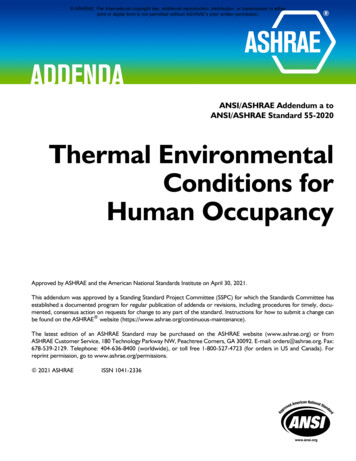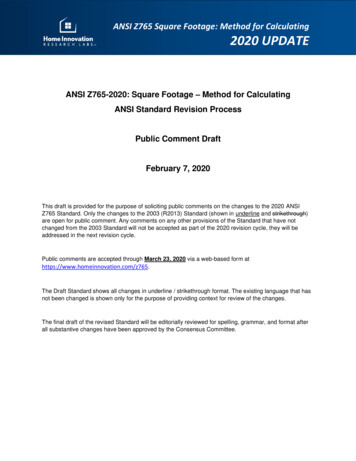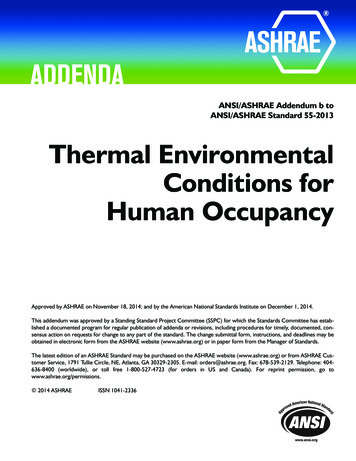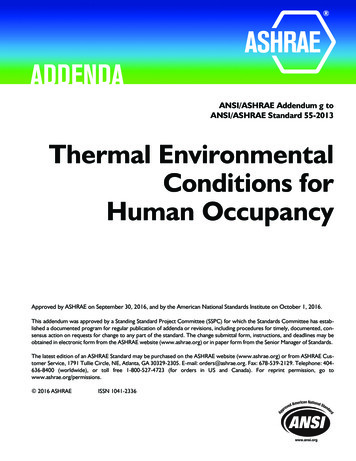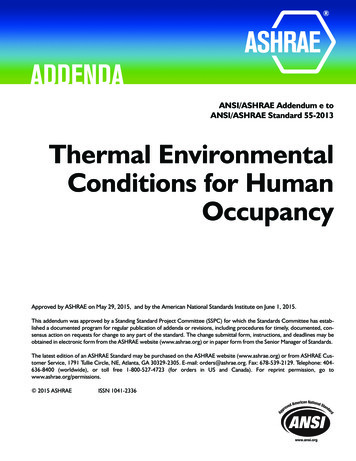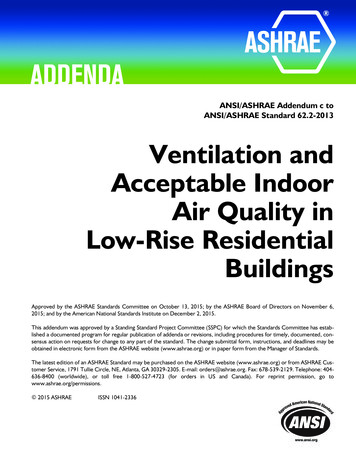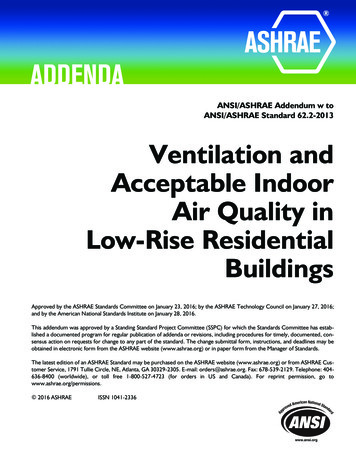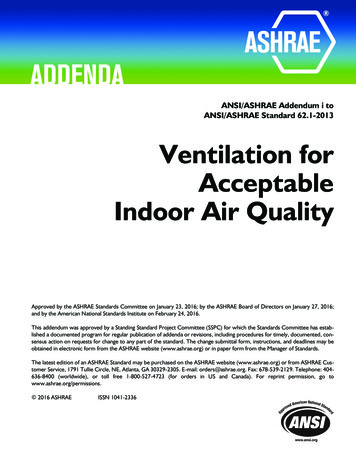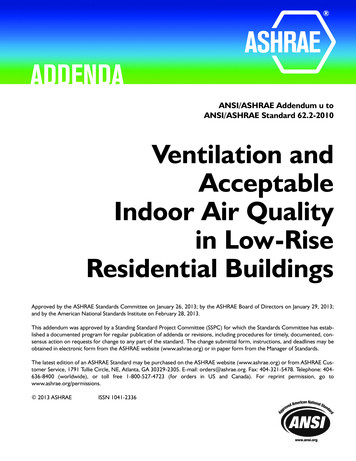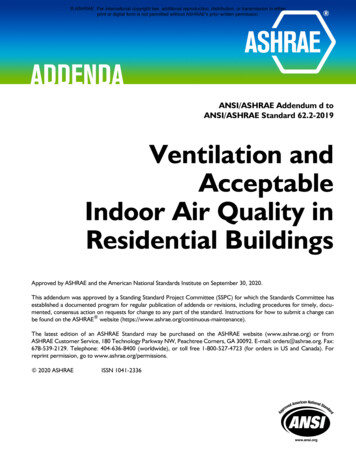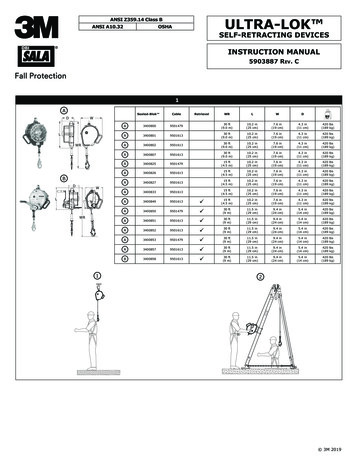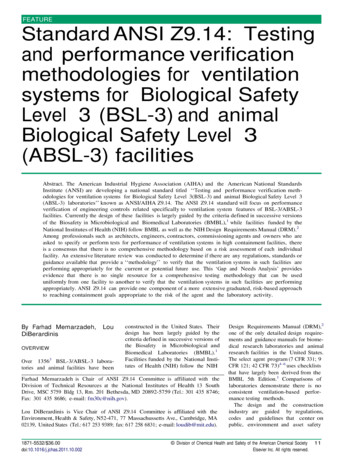
Transcription
FEATUREStandard ANSI Z9.14: Testingand performance verificationmethodologies for ventilationsystems for Biological SafetyLevel 3 (BSL-3) and animalBiological Safety Level 3(ABSL-3) facilitiesAbstract. The American Industrial Hygiene Association (AIHA) and the American National StandardsInstitute (ANSI) are developing a national standard titled ‘‘Testing and performance verification methodologies for ventilation systems for Biological Safety Level 3(BSL-3) and animal Biological Safety Level 3(ABSL-3) laboratories’’ known as ANSI/AIHA Z9.14. The ANSI Z9.14 standard will focus on performanceverification of engineering controls related specifically to ventilation system features of BSL-3/ABSL-3facilities. Currently the design of these facilities is largely guided by the criteria defined in successive versionsof the Biosafety in Microbiological and Biomedical Laboratories (BMBL),1 while facilities funded by theNational Institutes of Health (NIH) follow BMBL as well as the NIH Design Requirements Manual (DRM).2Among professionals such as architects, engineers, contractors, commissioning agents and owners who areasked to specify or perform tests for performance of ventilation systems in high containment facilities, thereis a consensus that there is no comprehensive methodology based on a risk assessment of each individualfacility. An extensive literature review was conducted to determine if there are any regulations, standards orguidance available that provide a ‘‘methodology’’ to verify that the ventilation systems in such facilities areperforming appropriately for the current or potential future use. This ‘Gap and Needs Analysis’ providesevidence that there is no single resource for a comprehensive testing methodology that can be useduniformly from one facility to another to verify that the ventilation systems in such facilities are performingappropriately. ANSI Z9.14 can provide one component of a more extensive graduated, risk-based approachto reaching containment goals appropriate to the risk of the agent and the laboratory activity.By Farhad Memarzadeh,DiBerardinisLouOVERVIEWOver 13563 BSL-3/ABSL-3 laboratories and animal facilities have beenconstructed in the United States. Theirdesign has been largely guided by thecriteria defined in successive versions ofthe Biosafety in Microbiological andBiomedical Laboratories (BMBL).1Facilities funded by the National Institutes of Health (NIH) follow the NIHFarhad Memarzadeh is Chair of ANSI Z9.14 Committee is affiliated with theDivision of Technical Resources at the National Institutes of Health 13 SouthDrive, MSC 5759 Bldg 13, Rm. 201 Bethesda, MD 20892-5759 (Tel.: 301 435 8746;Fax: 301 435 8686; e-mail: fm30c@nih.gov).Lou DiBerardinis is Vice Chair of ANSI Z9.14 Committee is affiliated with theEnvironment, Health & Safety, N52-471, 77 Massachussetts Ave., Cambridge, MA02139, United States (Tel.: 617 253 9389; fax: 617 258 6831; e-mail: loudib@mit.edu).1871-5532/ 36.00doi:10.1016/j.jchas.2011.10.002Design Requirements Manual (DRM),2one of the only detailed design requirements and guidance manuals for biomedical research laboratories and animalresearch facilities in the United States.The select agent program (7 CFR 331; 9CFR 121; 42 CFR 73)4–6 uses checkliststhat have largely been derived from theBMBL 5th Edition.1 Comparisons oflaboratories demonstrate there is noconsistent ventilation-based performance testing methods.The design and the constructionindustry are guided by regulations,codes and guidelines that center onpublic, environment and asset safety Division of Chemical Health and Safety of the American Chemical SocietyElsevier Inc. All rights reserved.11
and protection. It has become increasingly difficult to verify ventilationneeds for BSL-3/ABSL-3 containmentfacilities. Architects, engineers, contractors, commissioning agents andowners, etc. (stakeholders) haveattempted to define both design andtest criteria for containment test methods while regulatory authorities haverelied on risk assessments and performance based objectives that definepreferred outcomes without establishing methods to achieve expectations.For example, several agencies and jurisdictions have adopted BMBL as thegoverning document for design, construction and verification of BSL-3facilities. However, the language ofBMBL is non-prescriptive and, as withother prevailing guidelines, it leavestoo much room for interpretation inthe application of the guidelines. Adirect consequence of this is the enormous amount of time and expenseincurred to satisfy the‘subjective’demands imposed during testing andverification.The ventilation system of a high containment laboratory is central to itsperformance and operation and theultimate key to ensure that the environment is safe for human occupants,research animals and the environment.In many cases, high containment facility stakeholders have expressed concern at various milestones in thedesign, construction or operation oftheir facility that there is a lack ofuniformity in the ‘‘methodology’’ usedfrom one facility to another to verifythat the ventilation systems in suchfacilities are performing appropriately.Additionally, another factor to takeinto consideration in the developmentof ANSI Z9.14 is that if used as anApproved TestingMethodology, itcould help assuage public perceptionof safety control oversight. A standardsuch as ANSI Z9.14 would be desirable to provide consistency in theindustry and increase the confidenceof the public that such a facility isoperating properly.An extensive literature review wasconducted to determine what regulations, standards and guidance are currentlyavailable thatprovide a‘methodology’ to verify that the ventilation systems in high containment2facilities are performing appropriatelyfor the current or potential future use.Among professionals who are asked tospecify or perform tests for performance of ventilation systems in highcontainment facilities, there is a clearconsensus that although some specificrequirements and component testingprocedures may be found in somedocuments (e.g., ANSI Z9.5,7 NSF498), there is no single source for acomprehensive methodology that canbe used to perform a risk assessment ofeach individual facility.The ANSI Z9.14 standard will focuson performance verification of engineering controls related specificallyto ventilation system features ofBSL-3/ABSL-3 facilities. Such a standard would fill an identifiable gap asevidenced in this ‘Gap and Needs Analysis’. The standard can provide onecomponent of a more extensive graduated, risk-based approach to reachingcontainment goals appropriate to therisk of the agent and the laboratoryactivity.The methodologies in ANSI Z9.14will provide practical guidance toensure that all reasonable facility ventilation system controls and prudentpractices are in place to minimize, tothe greatest extent possible, the risksassociated with laboratory operationsand the use of biohazardous materialsas they are affected by the ventilationsystem. It will provide optional methods to validate that the facility cancontinue to perform at the safety levelfor which it was intended As well, thestandard will serve as an umbrellamethodology that ensures, validatesand accounts for the completion ofall other necessary and required processes or certifications. Thus, it isexpected that verification of applicableANSI/ASHRAE standards,9,10 NSFBiosafety Cabinet certifications,8,11ANSI/ASHRAE Fume Hood certification requirements, 12 NFPA requirements,13 etc. and any local code andstandard requirements will be a part ofthis standard by reference. VentilationSystems are affected by and have aneffect on other systems and equipmentin a laboratory and thus those systemsand equipment may be included in thestandard to some extent as an associated system. Because the standardwill primarily focus on ventilation systems, it will not include the specifications of a comprehensive bio-riskmanagement system which is coveredalready by the CWA 15793:2008.14However, the ANSI/AIHA Z9.14 willprovide the technical specificationsand background information neededto address the technical, engineeringand associated systems for ventilationwithin a high containment laboratory.As such, it is fully compatible with theCWA 15793:2008 and other nationaland international health and safetymanagement systems without duplicating or contradicting their requirements.Biosafety professionals are increasingly demanding the use of risk assessments to determine the Heating,Ventilation andAir Conditioning(HVAC) systemrequirements fordesign and testing. For example, thereis no basic BSL-3/ABSL-3 standardthat defines the extent of ventilationredundancy. This basic premise forsafe and continuous operations isessential to meet the new BMBL 5thEdition standard defined as, ‘Thelaboratory shall be designed such thatunder failure conditions the airflowwill not be reversed’.1 There are otherexamples of common laboratoryrequirements that can have many solutions without consistent guidance fortesting to achieve both prescriptive orperformance objectives. Specific gapsexist suggesting that a new performance testing standard is required.These include:1. There are minimal defined standards for BSL-3/ABSL-3 ventilation systemsthatareeitherperformance based or prescriptivein the USA. Although the NIHDesignRequirementsManual215and USDA ARS 242.1 are fairlyprescriptive in establishing minimum standards for ventilation system performance, neither providesa methodology to test ventilationperformance or performance verification methods for all BSL-3/ABSL-3 facilities.2. There are many BSL-3/ABSL-3facilities with similar functions andrisks that do NOT follow the sametesting methods for ventilation.Journal of Chemical Health & Safety, March/April 2012
3.4.5.6.7.8.9.In other words, there is no testingstandardization,uniformity orconsistency.There are many BSL-3/ABSL-3laboratories that cannot meet thecurrent ventilation recommendations of the BMBL 5th Edition for‘no air reversal’. Test methods toachieve this are absent.Many users of older laboratoriescannot meetcurrent ventilationrequirements of the BMBL 5th Edition when renovating or re-testing;they are requesting help as to howto perform tests.NIH commissioning standards arespecific to their own facilities anddo not provide methodologies forBSL-3/ABSL-3 ventilation systemstesting.The possession, use, and transfer ofselect agents and toxins that havethe potential to pose a severe threatto public health and safety, to animal or plant health, or to animal orplant products are regulated byselect agent rules 7 C.F.R. Part331,4 9 C.F.R. Part 121,5 and 42C.F.R. Part 73.6 These regulationsdo not define test methodologies forBSL-3/ABSL-3 performance verification.Animal and Plant Health Inspection Service (APHIS) standards [7C.F.R. Part 331 (APHIS-plant); 9C.F.R. Part 121 (APHIS animal)]4,5which regulate laboratories working with select agents and toxinsposing a risk to animal and planthealth or animal and plant productsdo not define methods for verifyingBSL-3/ABSL-3 ventilation performance.Although ANSI standards are basedin the United States, many countriesare interested in the outcome of thisproposed ANSI Z9.14 standard dueto the relative void in the globalbiosafety industry.Other countries are developing programs to verify evidence-based criteria for containment performance.Many professionals in the industry,who design, build and operate highcontainment facilities recognized fromtheir experience, that there is a lack ofuniformity in the ‘methodology’ usedfrom one facility to another to verifythat the ventilation systems in suchfacilities are performing appropriately.This fact is evident from a variety ofsources including the lack of literatureon the topic when one does an Internetsearch; frustration of engineers taskedwith testing facility ventilation systems, and discussions related to thistopic at national meetings. The ventilation system of a high containmentlaboratory is central to its performanceand operation and the ultimate key toensure that the environment is safe forhuman occupants, research animalsand the environment. It is importantto emphasize again that a direct consequence of the lack of clear and prescriptive languageinprevailingguidelines results in an enormousamount of additional time and expenseto satisfy the ‘subjective’ demandsimposed during testing and verification.This ‘Gap and Needs Analysis’ indicates that although there are manyguidance documents, there is no singledocument that provides a comprehensive methodology for testing and verifying that the ventilation systems inBSL-3/ABSL-3 facilities is performingappropriately.The following is a list and briefdescription of the available guidancepertaining tohighcontainmentlaboratories. This list is not exhaustivebut aims to address some of the morecommon guidance documents available to the professional community.As well, some of the documents listedmay have tangential bearing on guidance related to high containmentfacilities in that they should be considered in their application to facilitydesign but do not address ventilationsystems (e.g., Americans with Disabilities Act, some OSHA regulations, andother codes).GAO 09-574 ‘‘Report on High ContainmentLaboratories:NationalStrategy for Oversight Is Needed’’16provides evidence that strongly supports the need for the ANSI/AIHAZ9.14 standard. The GAO reportstates, ‘‘According to our expert panel,a clear and unambiguous set of standards stating the various capabilitiesthat are required to maintain theintegrityof all high-containmentlaboratories is necessary. TheseJournal of Chemical Health & Safety, March/April 2012standards should be national – notsubject to local interpretation – andaddress the possibility that one ormore emergency or backup systemsmay fail. Most importantly, any setof scenarios aimed at maintainingcontainment integrity must be empirically evaluated to demonstrate itseffectiveness.’’GAO report 09-57
Farhad Memarzadeh is Chair of ANSI Z9.14 Committee is affiliated with the Division of Technical Resources at the National Institutes of Health 13 South Drive, MSC 5759 Bldg 13, Rm. 201 Bethesda, MD 20892-5759 (Tel.: 301 435 8746; Fax: 301 435 8686; e-mail: fm30c@nih.gov).

